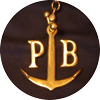
Phil's Boat
Software
This is written using the Arduino version of C, and libraries written for
Arduino controllers.
To be honest there isn't much that is clever about the software, however
there are a couple of things worth sharing.
The first is the trigonometry calculations, without using the standard
library. The second is how to run the Arduino in a low-power mode.
Trigonometry
Although the exact heading to the next way point is not necessary (because
the boat won't steer exactly where you want it anyway), the boat does want
to head in roughly the right direction. In practice it is pretty easy to get
the heading within a degree or so, which is probably much better than the
ability of the boat to follow a heading.
To calculate the desired heading from the current position, and the next
way-point uses both cos(theta) and arctan(a/b) (see below why I need this).
This would be easy if I just used the relevant Arduino library, but am
concerned that I may run out of program memory, and since I don't need very
good accuracy, I thought I'd investigate other methods.
The current position is obtained from the GPS unit as degrees lattitude and
longitude. To calculate the desired heading, I first calculate the
North-South distance to go, and also the East-West distance. Then I can
calculate the angle to head. Calculating the distance in the north-south
direction is very easy as distance across the surface of the ocean is simply
the difference in lattitude mutiplied by a constant. The constant is the
circumference of the earth divided by 360º. It is about 67 miles per degree,
or 111km per degree. The circumference of the earth is about 24,000 miles,
or 40,000km. The latter was how Napolean decided on the length of the metre,
ie 1/10,000,000 of the distance between the poles and the equator.
The east-west distance is not so easy, as the distance between lines of
longitude decreases away from the equator (and towards the poles). So to
know the distance in miles between where you are and where you want to be,
you need to allow for this variation. The multiplier between degrees of
longitude and miles decreases by cos(theta), where theta is the degrees of
lattitude. At the equator the scaling factor is the same as for lattitude,
ie 67 miles per degree. At 60º north for example the scaling is half of
this. So the mathematical formula for east-west distance is: 67 *
cos(lattitude) miles per degree. Therefore the system needs to be able to
calculate cos(theta). The obvious method to calculate cos(theta) is to use a
few terms in the Maclaurin
expansion. This is very simple, and is cos(x) = 1-x2/2+x4/24
and
so on (note that x has to be in radians: 360 degrees = 2?, ie 2 times pi or
6.28; so 1 radian is about 52 degrees). Taking advantage of the (hopeful)
fact that the boat won't get too close to the poles, only a very few terms
are needed to get an accuracy of better than needed. In practice, only the
x-squared term is needed to get better than 1% accuracy up to a lattitude of
55º, however I opted for the x4 term as well,
giving better than 0.2% up to 55º.
The bearing is the angle of the line that is the hypotenuse of the
right-angled triangle created by the north-south and the east-west
distances. If N is the north-south distance, and E is the east-west
distance, then the angle needed is arctan(N/E), which is in radians. So the
bearing is 360/2/?*arctan(N/E). For the reasons of memory saving described
above, I wanted an easy mathematical way to calculate arctan(),
approximately (to better than 1 degree). Looking at a graph of
arctan(), you can see that between 0 and 45º, the graph is
reasonably straight, but from 45º to 90º it is much more curved. After that
it repeats. However, I can take advantage that by swopping the N and E
dimensions, I am effectively drawing the same triangle rotated by 90º, and
so the angle I care about can always be less than 45º.
(In more algebraic terms, arctan(N/E) = 90º-arctan(E/N).) So I really only
need a way of calculating arctan() that is OK up to 45º and don't care if is
badly inaccurate from 45º to 90º. I can also change the sign of the N and E
distances to allow for the boat going south (when N is actually negative)
instead of north for example. Back to arctan(): since it is a pretty smooth
curve up to 45º, I thought a simple quadratic polynomial might do (something
like: bearing angle = a+b(N/E) + c(N/E)2). With a
quick bit of work using Excel solver, and forcing the values so that it
gives the correct values at 0 and 45º, a=0 (this is obvious), b=60.7974, and
c = -15.7974. Using this gives a worst error of less than one-quarter of a
degree from zero to 45º: perfectly good enough for the boat.
So that's how the heading calculations are done without the trignometry
library.
If you look here,
there is a very nice, simple way of calculating arctan from the lengths of
the two sides. Unfortunately, it requires the length of the hypotenuse of
the triangle to be 1, which would mean calculating the square root of a
number at some point. This isn't very easy either, so I didn't use this.
Low Power Operation
To be continued...
